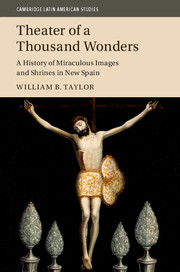Book contents
- Frontmatter
- Dedication
- Contents
- List of Figures
- List of Maps
- List of Tables
- Preface and Acknowledgments
- Archive Abbreviations
- Introduction
- Part I Bearings: Historical Patterns and Places of Image Shrines
- Part II Soundings: Divine Presence, Place, and the Power of Things
- 5 Making Miracles
- 6 Relics, Images, and Other Numinous Things
- 7 Religious Prints and Their Uses
- 8 Placing the Cross in Colonial Mexico
- 9 Pilgrims, Processions, and Romerías
- Conclusion
- Appendix 1 Colonial Image Shrines
- Appendix 2 When Shrines Began
- Appendix 3 Other Saints
- Index
8 - Placing the Cross in Colonial Mexico
from Part II - Soundings: Divine Presence, Place, and the Power of Things
Published online by Cambridge University Press: 05 September 2016
- Frontmatter
- Dedication
- Contents
- List of Figures
- List of Maps
- List of Tables
- Preface and Acknowledgments
- Archive Abbreviations
- Introduction
- Part I Bearings: Historical Patterns and Places of Image Shrines
- Part II Soundings: Divine Presence, Place, and the Power of Things
- 5 Making Miracles
- 6 Relics, Images, and Other Numinous Things
- 7 Religious Prints and Their Uses
- 8 Placing the Cross in Colonial Mexico
- 9 Pilgrims, Processions, and Romerías
- Conclusion
- Appendix 1 Colonial Image Shrines
- Appendix 2 When Shrines Began
- Appendix 3 Other Saints
- Index
Summary
In 1960, the May 3 feast of the Invention of the Holy Cross was officially removed from the liturgical calendar in order to focus devotion to the Holy Cross on September 14, the day of the Exaltation of the Cross. But for many Mexicans this favorite feast day was a lifeline to well-being here and now and the promise of salvation hereafter. It was an essential practice, not a vestigial one. Communities all over Mexico, especially rural towns and villages, observe May 3, decorating their special crosses in public and private places, attending Mass, and celebrating with food, drink, fireworks, music, and dancing. Workers in the building trades were conspicuous dissenters in 1960; virtually every construction site in Mexico must have its protective cross, which is decorated and honored on May 3. To steer clear of a prolonged dispute over popular traditions of faith, Mexican bishops successfully appealed to Rome for May 3 to remain a major feast there.
May 3, then, is still widely celebrated in Mexico, as well as in El Salvador and various communities in Spain, as it was during the colonial period. References to outdoor festivities on May 3 abound in early church chronicles, cathedral chapter minutes, parish archives, and civil and religious regulations and court records, especially for the seventeenth and eighteenth centuries. In Valladolid (now Morelia, Michoacán), celebrations in 1629 included a mock battle of Moors and Christians that concluded with the Christians wresting the cross from the infidels. During the festivities that year, a stone cross on the house of one of the cathedral dignitaries was damaged, leading to an inquiry into possible sacrilegious intentions. This mixing of sacred and profane evidently was common, and a worry to authorities. May 3 processions with family and community crosses to hilltop Calvaries were also a common practice then. Mass was celebrated on the spot, followed by the usual festivities. Spirited gatherings mixing sorrow and joy in the presence of the cross were a concern of the Inquisition in March 1691 when it prohibited celebrations in the streets of Mexico City on the grounds that some crosses were placed in “indecent locations, and the celebrations with Mass, sermon, and processions were mixed up with farces, bullfights, and masquerades on the pretext of honoring the cross,” which “results in serious scandal in the Christian Republic.”
- Type
- Chapter
- Information
- Theater of a Thousand WondersA History of Miraculous Images and Shrines in New Spain, pp. 454 - 501Publisher: Cambridge University PressPrint publication year: 2016

